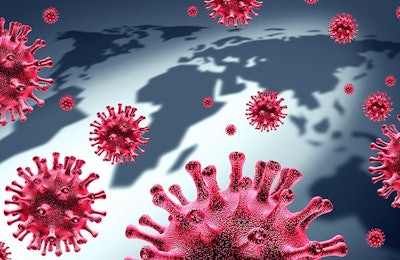
COVID-19 is presenting an unprecedented challenge to the world and the U.S. poultry industry will not be spared from its effects. However, it will likely not be significantly interrupted by the disease.
Will business be disrupted?
The largest concern, according to industry organizations, is the continuation of business in the rapidly changing environment. There is worry production could be reduced or frozen due to a worker shortage or mandated plant closure. Already seven of the nation’s largest poultry companies – Sanderson Farms Inc., Perdue Foods, Foster Farms, Mountaire Farms, Wayne Farms LLC, Empire Kosher and House of Raeford Farms – have announced a COVID-19 case at their processing plants.
Dr. Ashley Peterson, senior vice president of scientific and regulatory affairs at the National Chicken Council (NCC), said many in the industry are concerned about what a positive test may mean for their operation.
The companies, she said, are dealing with a disparate network of states and health departments. The industry lacks clarity in how each jurisdiction will respond, but its buoyed by the declaration of the industry as an essential, critical infrastructure by the U.S. Department of Homeland Security. Ultimately, any potential closure or disruption of processing will be judged on a case-by-case basis.
She also said its unlikely poultry farmers in the U.S. will deal with any logistical challenges due to the disease. Unlike Europe and Asia, where poultry industries are suffering from the effects of movement controls, the U.S. industry is highly integrated and food producing industries and transportation are considered critical. As of now, chicks will move and birds will be fed and processed.
Will plants stay open?
As school close and workers or their loved ones potentially fall ill, the industry is prepared for a degree of absences. Tom Super, NCC’s senior vice president of communications, said worker absences are part of poultry processing so effects should be somewhat limited.
At the processing plants, social distancing and disinfection practices are elevated. Access to visitors is further limited. Sick workers are told to stay home. Medical and family leave policies now include COVID-19 considerations.

Worker absenteeism is part of poultry processing. Larger concerns lie with potential shutdowns due to a COVID-19 case at a plant. | (andresr | iStockPhoto.com)
On March 31, 2020, Tyson Foods Inc., the country’s largest chicken processor, announced plans to start using temporal thermometers to check the temperature of employees before entering company facilities. Moreover, its offering protective face coverings to production workers who request them. On April 2, 2020, Sanderson said it would begin checking temperatures, too.
Processors like Jennie-O Turkey Store parent Hormel Foods Inc., Tyson and Sanderson are offering temporary cash attendance bonuses to their workers to keep them on the job through the pandemic.
Coordinating an industry-wide response
U.S. Poultry & Egg Association (USPOULTRY) President John Starkey said the entire poultry industry – including other bird producers – are viewing COVID-19 as non-competitive and are working to coordinate a response. Both USPOULTRY and NCC are maintaining webpages to spread relevant news and information with its membership about COVID-19.
Like much of the world, the industry was forced to quickly adjust to a new normal. The association’s initial response, Starkey said, was surveying the industry to see if it was adjusting its leave, travel and sick pay policies. As states and cities began to issue lockdown orders, the industry conferred over the phone to discuss the situation. On March 27, 2020, USPOULTRY issued a second, more detailed survey about disease response procedures.
Super said the Washington-based industry group is monitoring the situation as it develops, working with regulators and the industry and is watching for significant legislative action. Congress already passed one stimulus package and is expected to take further action in the future.
The industry organizations applauded the Federal Motor Carrier Safety Administration’s action to relax hours of service limits for truck drivers. This allows drivers to work longer than usual in order to keep the supply chain moving. Industry associations are also working with the U.S. Department of Agriculture Food Safety and Inspection Service in order to ease the flow of product that was marked for foodservice sale to retail channels.
Domestic economic impacts
In March 2020, consumers stripped store shelves in preparation for a potential prolonged quarantine. Now – with non-essential businesses shuttered, travel discouraged and many staying at home – foodservice and restaurant demand is down sharply while retail demand is skyrocketing. Analysts predict weak demand from restaurants and foodservice and more from retailers and those who capitalize on the home delivery market.

More people are eating home instead of going out. Retailers and home delivery companies will benefit while foodservice and restaurants suffer. | (monkeybusinessimages | BigStock.com)
On April 2, 2020, Sanderson said its changing production plans based on elevated demand for retail, traypack chicken and evaporating demand for its big birds raised for food service. The company plans on slaughtering birds earlier, reducing its setting of eggs and shifting its production practices to meet both the temporary and forecasted long term increase in demand.
Right now, the domestic industry is poised to meet growing demand for fresh meat, as several new processing plants were brought online last year raising overall production capacity. Paul Aho, an economist and consultant with Poultry Perspective, said the U.S. is likely to enter a recession in 2020 due to COVID-19 and the poultry industry will be overproducing in that scenario.
According to lessons learned in the last economic downturn, people will keep eating chicken but they will eat less, he said. In the event of a slight downturn, demand for chicken will rise while demand for other proteins falls. If things are worse, demand for all proteins will fall. In this situation, Aho said its likely some older processing plants may close.
There is hope the U.S. and world economy will normalize after the disease challenge fades, but its unknown how long that will last. Aho said the disease may well recede in June and July 2020 only to return in the fall months so a recession may stretch into 2021.
Global economic impacts
On a global level, COVID-19 is predicted to have a material affect for poultry. In Rabobank’s second quarter report on the poultry industry, Nan-Dirk Mulder, its senior analyst covering animal protein, and its animal protein team wrote that the disease will likely cause a global economic slowdown. Demand for poultry could grow due to its price competitiveness against other proteins.

COVID-19 could have far ranging impacts on the U.S. and global economies in 2020 and beyond. Poultry may benefit from its price competitiveness. (scaliger | Bigstock)
The same report said that the availability and prices of animal health and feed additives originating from China could be temporarily disrupted by the disease due to its role in markets like vitamins, threonine, and lysine. These industries have been impacted by plant closures.
The Rabobank report raised the issue of disruption in exports due to COVID-19. The U.S. recently resumed exports to China and anticipated high demand in the country going forward. More clarity is needed to become more confident in what may happen on that front, the report said.
Aho said China will continue to need animal protein due to its losses caused by the African swine fever, so there should be a market for U.S. proteins there. However, if demand drops elsewhere around the world due to COVID-19 any gains in China could be negated by losses elsewhere.
View our continuing coverage of the coronavirus/COVID-19 pandemic.


















